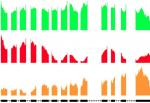Multimappers can be more complicated than what's shown in the example in Activity 2. In Activity 3, we look at the case where a read aligns to three different locations on the genome. How do you tell which alignment is correct now?
Click on the image to view the presentation in your web browser or download the PowerPoint slide show (ppsx format). The content in each format is the same.
Discussion Questions
1. In the Activity 3 presentation, what happened when you increased the read length? Did knowing the identity of more of the base pairs in the read help you decide whether Alignment 1, 2, or 3 was the correct alignment?
2. Did adding paired-end sequencing information allow the researcher to tell whether Alignment 1 or Alignment 2 was correct? Describe the situation in the example where the paired-end sequencing information can match both Alignments 1 and 2.
3. In the example, could you tell if Alignment 1 or 2 was correct when you have the following information? Explain why.
a) Additional fragment length information: The RNA fragments that you sequenced were 100—200 base pairs long (bp).
b) Fragment length based on possible alignments of paired-end reads: Alignment 1 = 150 bp, Alignment 2 = 500 bp
4. Challenge question
You are analyzing RNA from an organism with a small genome that has very few repeated sequences. There is almost no chance of seeing multimappers. Which modifications (increasing read length, using paired-end data, using fragment length information) would you choose, if any?


 Discovering the Genome
Discovering the Genome
